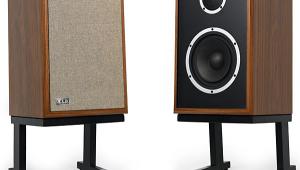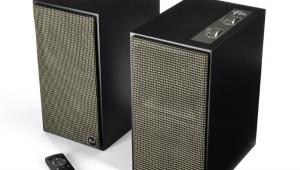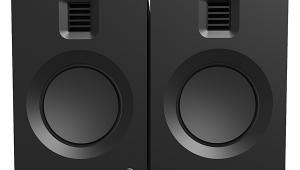Boston Acoustics M25 Speaker System Page 2
The M Series did not give me a single moment of discomfort. While it fell short of reference quality, it was an excellent entertainer, with a gentle top-end restraint that made listening to it a relaxing experience. Power handling was better than average for a system at this price. The M25 monitors had good bass for their size though not quite enough to operate alone. The MCenter communicated voices at all levels, its BMR driver dispersed middle and high frequencies widely, and its woofers dovetailed well with the sub, though the speaker downplayed some details of vocal timbre and enunciation. The MSurround was surprisingly reticent, sometimes undercutting the integrity of the soundfield—to the point where I checked the levels to rule out a setup mistake. Don’t think of this as a deal breaker: If I’d been living with these speakers, as opposed to reviewing them, I’d have set the surround levels a couple of decibels higher than the front channels.
The unexpected star of the show was the MSubwoofer, which delivered loads of bass output and dynamics without flinching. A bass peak was noticeable, probably at least somewhat due to my room’s standing wave—some subs aggravate it more than others. See our Measurement Box for the actual response. However, room correction might have sculpted it into a nearly ideal sub—if my reviewer’s code of honor did not preclude the use of room correction as a variable that stands between me and a speaker system’s essential character.

Movies (and TV shows with movie-caliber soundtracks) proved to be the strong suit of the M Series, and I watched more than the normal quota just for the pleasure of it. House of Cards, the Netflix streaming series with a Dolby Digital Plus soundtrack, had some deep bass content in the opening score, and it sounded big and beautiful through the sub and speakers. Via the MCenter, Kevin Spacey donning a South Carolina accent was as close to music as a Congressional villain ever gets. An episode of CSI: Crime Scene Investigation directed by Quentin Tarantino (“Grave Danger”) caused the sub to explode. Oh, all right, it just delivered an explosion in the soundtrack, but it sounded as if something exploded. The horror flick Playback kicked off with the new DTS logo, featuring a descending bass figure that the sub delivered with aplomb. The undercurrent of low-level looming-horror bass effects that ran throughout the film gave the sub a chance to be subtle.
A quick explosion is one thing—one that lasts for several dramatically extended seconds is more of a challenge. Act of Valor, an action movie based on Navy SEALs, featured such an effect, and the sub maintained control over it for the entire duration. This movie also gave the MSurround a chance to show what it could do with effects (street and jungle noises) and music (flute-dominated score). Sometimes the surrounds provided a subtle but discernible wraparound, sometimes they just pulled the front soundstage slightly toward the rear, and sometimes I had to put my ear to the speakers to make sure the surround channels were operating. (Again: Raising surround levels would have been an easy fix.)
John Carter plunges a 19th century earthling into Martian civil war. The soundfield was generously large, though still heavily concentrated in front. The orchestral score and vocal reproduction were smooth and well integrated, even when they had to share the soundfield with aggressive effects. Few systems at this price would be able to make the constant high-level onslaught of this movie so palatable and fatigue-free. A system with more resolution would probably have had me turning down the volume. When the source material became demanding, and the receiver pumped out extra power, the speakers rose unfailingly to the task.

Diplomacy and Evasion
In the music demos, the M Series proved itself better at varnishing the truth than telling it. Sometimes this was decidedly an advantage. When I first heard the Led Zeppelin reunion concert video Celebration Day through my reference system, I found the guitar sound way too hot. Jimmy Page has always favored a snarling fuzz box in concert, as I reminded myself with the vinyl version of The Song Remains the Same. But on the 2007 reunion concert it seemed to overwhelm all the other instruments, submerging the vocal and even competing with the rhythm section. Then I replayed it through the M Series. What a difference: The guitar receded a bit, Robert Plant’s vocals suddenly shone through the mix, and everything seemed in better proportion. The MSubwoofer got along well with the rhythm section, with bass-pitch definition for John Paul Jones and impact for Jason Bonham. Interestingly, the MP3 files sounded almost equally coherent through an iPad. That was the aha moment: I realized the speakers were voiced to roll-off aggressive treble, potentially lending a more comfortable sound to a lot of rock today’s recordings.
Haydn’s Middle Period Trios, played by the Haydn-Trio of Vienna, arrived in a box set of four Telefunken LPs. (Having long owned boxes of the early and late trios, I was delighted to fill this hole in my collection.) This set is among the best chamber music recordings in my collection. I wouldn’t say the M25 dumbed it down: The violin emerged with its woody body intact, and the piano was well imaged between the speakers, a foot or so behind the violin and cello. But sometimes it was hard to follow the cello, even though it had a space of its own in the right channel. Here is where my Paradigm Studio 20 outperformed the Boston M25: Suddenly I could hear the cello easily, and the other two instruments took on more timbre and tone color. There was more apparent resolution across the spectrum.
Deep River and Other Spirituals features the incomparable unaccompanied vocals of the Robert Shaw Chorale in an RCA Living Stereo LP from 1958. The M25 did what good speakers do with this music: lift it clear of the speakers and trace its gentle dynamic rise and fall. The monitors reinforced Shaw’s voice-blending discipline, never letting individual singers detach from the chorus except for soloists. They made the massed vocals more of a wash of sound, less granular, than my reference speakers—and the warmth was warmer, the sibilants softer—but the net effect was equally gratifying.
The Boston Acoustics M Series is thoroughly up to the moment. It is a beautiful-looking product. The sub is a potent performer. Given a chance, the system really rocked out. While not quite an audiophile speaker—the kind that resolves every last measure of timbre, ambience, and air in the recording—the monitor is forgiving, unfatiguing, and reasonably sympathetic to every kind of music and all the movie soundtracks I threw at it. It’s about how I perceive a “mainstream” home theater–worthy speaker system ought to look and sound.
Audio editor Mark Fleischmann is also the author of the annually updated book Practical Home Theater (quietriverpress.com).




























































